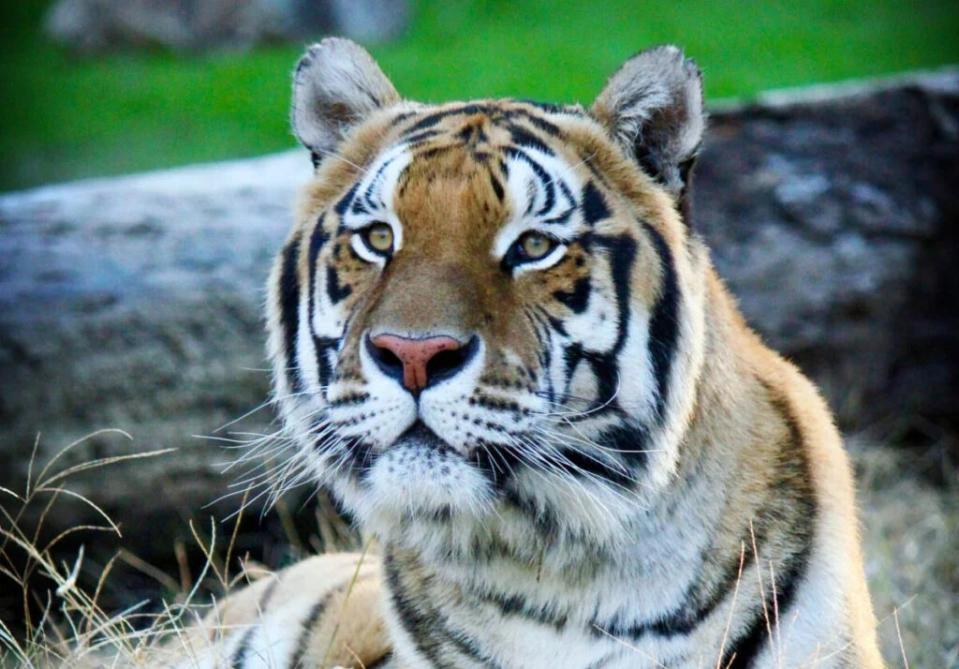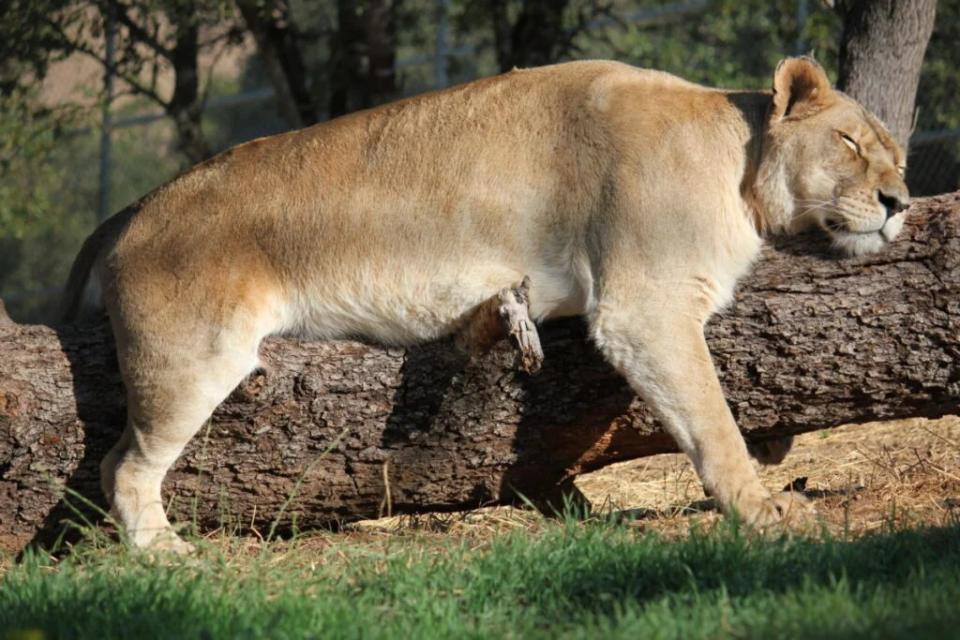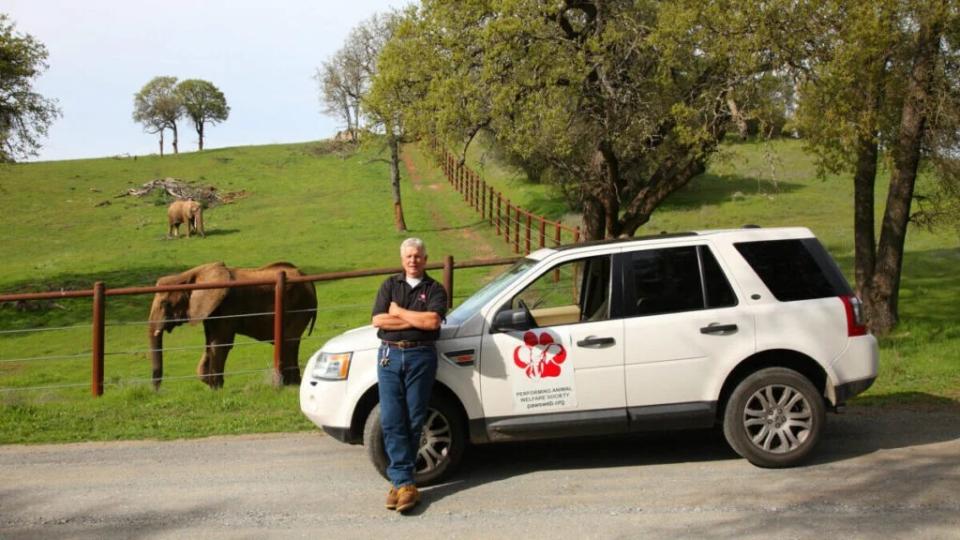Fur-loughed: With Hollywood on Strike, Animals Are Out of Work Too
- Oops!Something went wrong.Please try again later.
The ongoing SAG-AFTRA and WGA strikes might have a silver lining for at least some unemployed actors – the four-legged kind.
With nearly all Hollywood film productions halted, many of the hardworking animal actors have had the last few months off. And while they’re not sipping piña coladas by the pool, some animals may be getting more care and attention from their owners as a result. Others, meanwhile, could be in more precarious positions — especially as the time spent between productions can oftentimes be the most dangerous for animal actors due to unsafe living conditions, unskilled trainers and lack of oversight.
The strike “won’t ever affect the horses as far as them being taken care of,” said stunt and livestock coordinator Tad Griffith of a Tad Western Production Company in Agua Dulce. He keeps all the animals he works with for life and considers them part of the family.
“We have more time to take care of them now than ever because we’re not doing anything else,” he added.
But that doesn’t mean that all animal actors are safe and content during these strikes. While animal injuries and deaths sometimes happen during filming, these creatures are particularly vulnerable when the cameras are not rolling, animal rights’ advocates say.

Like many of their human co-stars, some animals used in filming have side hustles. They perform or make appearances at birthday parties, petting zoos, photo opps and live shows. Those are all occasions where they can be harmed or harm others, and they are less strictly monitored than film sets. And much of the problematic treatment of animals on the part of less skilled or scrupulous trainers, suppliers or breeders takes place before and after filming.
“Most abuse takes place off set during training and in living conditions,” said Courtney Penley, assistant manager of People for the Ethical Treatment of Animals’ film and TV division.
PETA has compiled a worst-offender list of about a dozen animal suppliers and trainers that have been repeatedly cited by the U.S. Department of Agriculture for violations, which it distributes on request. The list includes businesses that have illegally imported wild animals, failed to provide adequate veterinary care, failed to keep enclosures clean and in good repair or housed dogs in enclosures not tall enough for them to stand up fully, among other offenses.
‘No animals were harmed’
When people think of animals on screen, the ubiquitous message that “no animals were harmed” in a production leaps to mind. First used in 1972, the disclaimer has its roots in work that American Humane undertook in 1940 to monitor the conditions of animals used on Hollywood sets. It’s now used in more than 1,000 productions a year.
Many in the industry say the organization has certainly improved safety for animals during filming. However, its limitations have been highlighted over the years in light of some highly publicized animal deaths. Among them were the deaths of up to 27 animals during the filming of “The Hobbit: An Unexpected Journey” in New Zealand largely due to allegedly unsafe living conditions at a farm used in production. (The film nevertheless received the following tagline: “American Humane Association monitored all of the significant animal action. No animals were harmed during such action.”)
American Humane reviews scripts before production, consults with productions on the organization’s safety guidelines and monitors animal-related activity and conditions on set. Its certified animal safety representatives also consider animal husbandry – the day-to-day care and raising of animals – and animal welfare before filming begins and after it wraps, according to the organization. But its focus is conditions on set.
“There are many animal-centric productions where American Humane has observed training and animal conditions,” the organization said by email. However, “this monitoring must be prioritized due to limited resources.”
Government regulators are technically charged with overseeing the transportation, sale and handling of certain animals, including those used for exhibition purposes. Inspectors for the federal Department of Agriculture – assess animal facilities under standards set in the Animal Welfare Act.
“If a facility is meeting the federal standards, USDA knows the animals there are receiving humane care and treatment,” the agency’s website reads.
But advocates like Christopher Berry, managing attorney at the Northern California-based Animal Legal Defense Fund, said the 1966 law is a bare-bones law that tolerates inhumane treatment of animals.
For example, the act provides a minimum cage size to keep the animal that’s only a little bit larger than the animal’s body, Berry said. Cages for dogs kept for breeding or exhibition purposes can be six inches longer and wider than the dog’s length and width.
“And there is an exercise requirement that can be discharged by just doubling the size of that cage so it’s essentially a cage that’s roughly the size of two dogs squared, and you can leave a dog in an enclosure like that for their entire life and that would be USDA compliant,” Berry said.
For many animals, the Animal Welfare Act also doesn’t require enrichment, like toys that would provide play and stimulation, nor does it prohibit killing animals for exhibition, Berry said.
Animals rented for production spend most of their off-set lives under such regulations.

Meanwhile, some animals including horses not used for research purposes and reptiles are not even covered by the Animal Welfare Act, PETA’s Penley said. Moreover, there is no government agency that regularly monitors the use of animals in filming or the use of endangered species in films, she said.
Cage to stage
Most wild animals that work in film live in a cage, since that’s the only way to keep a movie animal, noted Ed Stewart, president and cofounder of the Performing Animal Welfare Society.
“It’s easy to watch a movie, think it’s fun, animals are cute and forget about it,” he said. “But think about a lion living in a cage for 20 years just to do a couple of movies and entertain you.”
Even many dogs who work in film live in small cages in kennels, he said.
While some say California has strict regulations, Stewart said the state’s caging regulations are “horrible.”
For example, a tiger or a black bear can be kept in 300-square-foot cages, while a mountain lion can be kept in a cage as small as 200 square feet, and an elephant can be chained by its legs for 19 hours a day under the state regulations, Stewart said.
“You can’t deny they are locked up and bred and sold and bought for entertainment and … that’s where they live their whole life unless they’re being trained on a set,” he said.
Animal rights’ groups say there is no need to exploit animals for human entertainment at all – particularly with the kind of computer-generated imagery used in high-profile films such as “Call of the Wild” and “Guardians of the Galaxy Vol. 3.”
In 2020, exotic animals were banned from use in California circuses partly due to heightened awareness of the conditions in which these animals were being housed.

PAWS has a sanctuary for wild animals in Northern California that have either been abused or couldn’t be kept by their owners. Some of the animals at their 2,300-acre Ark 2000 sanctuary are kept in large cages, Stewart said, “but the difference is we don’t buy them [and] we don’t create a market for them.”
Even those who regularly work with animals in film say more can be done to protect them.
Griffith, who has an extensive safety protocol to protect his western livestock animals and riders, thinks trainers who have proven to be safety conscious should be spotlighted in some way.
“There’s no recognized list of humane trainers who have shown a track record of being safe and humane,” Griffith said. Productions “can hire any horse from anybody. They can hire a horse they see down the road” rather than a well-trained one handled by a skilled and humane trainer.
American Humane does not make recommendations regarding animal trainers, but encourages productions to do their own due diligence in hiring animal trainers “as they would for any crew member,” the organization said. It said it would also advise productions if they were aware of any trainer who had been charged and/or found guilty of violating animal welfare regulations or laws.
Griffith is skeptical that demand for real, live animals in Hollywood will go away, despite the fact that many filmmakers have opted to use CGI for depictions of both domestic and wild animals in film. Instead, he thinks that the more technology is used to generate images of animals, the more that real interactions with them in film will be appreciated.
“I love CGI. I can go to a sci-fi movie and just love it,” Griffith said. But, he added, “I love real stunts equally as much because I know it’s all real.”
The post Fur-loughed: With Hollywood on Strike, Animals Are Out of Work Too appeared first on TheWrap.

